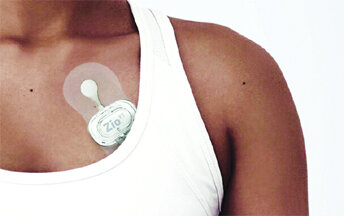A team of researchers in the United States has unveiled a groundbreaking wearable device designed for continuous heart monitoring, potentially revolutionizing the diagnosis of atrial fibrillation (AFib). This innovation, hailed for its potential to identify significantly more cases of AFib—a condition closely linked to stroke and heart failure—than conventional care methods, was developed by experts at the Duke Clinical Research Institute, North Carolina.
Renato Lopes, Professor of Medicine at the Duke Clinical Research Institute and the study’s lead author, emphasized the often undetected nature of atrial fibrillation and its serious health implications. “Atrial fibrillation is frequently undiagnosed and can elevate the risk of ischemic stroke, which is largely preventable with oral anticoagulation,” Lopes noted. Despite these promising findings, he stressed the necessity of further research to confirm whether systematic screening and subsequent anticoagulant therapy could indeed reduce stroke risk.
Published in the Journal of the American College of Cardiology, the study is notable for its scale and rigorous methodology. Enrolling approximately 12,000 elderly participants across the U.S., all aged 70 and above with no prior AFib history, the researchers sought to compare the efficacy of the new wearable device against standard care practices. Participants were randomly divided, with one group assigned a continuous heart monitoring device for 14 days, while the control group received usual care.
After a 15-month follow-up period, results were compelling. The use of the continuous monitoring device led to a 52% increase in AFib detection compared to usual care. However, despite this improvement in diagnosis, researchers did not find a corresponding decrease in stroke-related hospitalizations.
This finding underscores a nuanced challenge in cardiology: while greater detection of atrial fibrillation is an essential step forward, it doesn’t automatically translate to reduced hospitalizations. The study also highlighted that hospitalizations for bleeding did not rise, a critical consideration for any intervention involving anticoagulation therapies.
Heart rate monitors, including those integrated into modern smartwatches, have become increasingly popular tools for tracking heart and pulse rates. These devices offer valuable features for monitoring heart rate during exercise and stressful activities and can alert users to irregular heart rhythms. However, Lopes cautions that such consumer-grade devices are not substitutes for medically accurate monitoring tools, which provide a higher precision critical in clinical diagnostics.
In essence, while the wearable heart monitor represents a significant advancement in the early detection of atrial fibrillation, further investigation is required to establish its role in comprehensive stroke prevention strategies. This study marks a crucial step towards integrating advanced technology into proactive healthcare, aiming to enhance early diagnosis and tailored treatment for at-risk populations.


